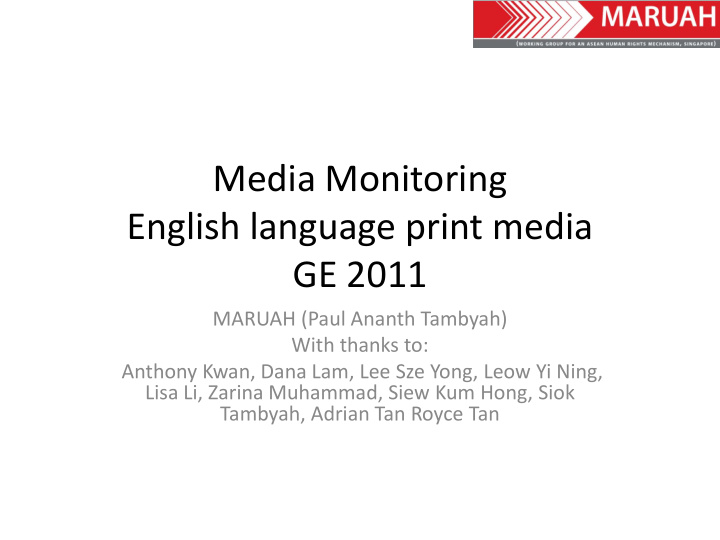



Media Monitoring English language print media GE 2011 MARUAH (Paul Ananth Tambyah) With thanks to: Anthony Kwan, Dana Lam, Lee Sze Yong, Leow Yi Ning, Lisa Li, Zarina Muhammad, Siew Kum Hong, Siok Tambyah, Adrian Tan Royce Tan
Disclaimer • This presentation is entirely in my personal capacity and has nothing to do with NUS etc • The data presented were collected by a number of individuals but I am responsible for the analysis, mistakes and all • Although I have helped out with the SDP (mainly) and RP and SPP, I do not belong to any political party or would be thrown out of MARUAH
http://www.ohchr.org/EN/Issues/Pages/ WhatareHumanRights.aspx www.udhr.org
Human rights critical to our history http://en.wikiquote.org/wiki/Lee_Kuan_Yew
From the UDHR www.udhr.org
AIMS • To objectively measure the relative impartiality of the print media during the GE 2011 Election Campaign period • To contribute to the process of free and fair elections in Singapore as part of our rights as citizens under UDHR
Methods: 1. Quantitative coverage of the different political parties 2. Qualitative coverage - images of candidates from the different political parties 3. Qualitative coverage – placement of stories reporting the different political party messages
Methods II: • Each volunteer collected data on column inches, headlines, themes, images and placement of stories daily • There were three trained reviewers per paper • An average was obtained if results were discrepant • If there were wide discrepancies, a fourth reviewer was involved and the differences adjudicated
Data Gathering Neutral or negative pictures Front page placement 2 column inches x 5 =10 column inches
Data gathering Placement Positive images
Whole paper including letters
Results: Overall Cumulative Coverage TOTAL Coverage: ST,TODAY,TNP 5000 4500 4000 3500 Column inches 3000 2500 2000 1500 1000 500 0 PAP NSP RP SDA SDP SPP WP
Results: Coverage by Paper 3500 3000 2500 Column inches 2000 ST TODAY TNP 1500 1000 500 0 PAP NSP RP SDA SDP SPP WP
Results: Straits Times Daily Quantitative Coverage 450 400 350 PAP 300 Column inches NSP 250 RP 200 SDA 150 SDP 100 SPP 50 WP 0 Date
Relative Coverage: By political parties 1 0.9 0.8 0.7 0.6 ST TODAY TNP 0.5 0.4 0.3 0.2 0.1 0 PAP NSP RP SDA SDP SPP WP
Size and Voice: Quantitative Coverage by No. of Candidates Coverage/candidate 40 35 Column inches/candidate 30 25 20 15 10 5 0 PAP(82) NSP(24) RP(11) SDA(7) SDP(11) SPP(7) WP(23) ST TODAY TNP
Results: Positive images Total positive pictures: ST, TODAY, TNP Number of pictures with smiling candidates 350 300 250 200 150 100 50 0 PAP NSP RP SDA SDP SPP WP
Results: Positive images by paper 250 Number of pictures with smiling candidates 200 150 ST TODAY TNP 100 50 0 PAP NSP RP SDA SDP SPP WP
Positive images by number of candidates: Size matters 3.5 ST TODAY TNP Smiling pictures per candidate 3 2.5 2 1.5 1 0.5 0 PAP(82) NSP(24) RP(11) SDA(7) SDP(11) SPP(7) WP(23)
Results: Placement How many pages do you need to flip? PAP NSP RP SDA SDP SPP WP 0 Average first page message appears 2 4 6 8 10 12 14 16 ST TODAY TNP 18 20
Results: Placement: Front-page 12 10 Number of days with Page One stories ST TODAY TNP 8 6 4 2 0 PAP NSP RP SDA SDP SPP WP
Results: “Blackout days” 9 8 Days with no coverage at all ST TODAY TNP 7 6 5 4 3 2 1 0 PAP NSP RP SDA SDP SPP WP
From Wikipedia
Placement and Outcome??* Blackout days and vote share 70 60 % vote in contested wards 50 40 30 20 y = 0.1105x 2 - 3.0025x + 51.523 10 R² = 0.7091 0 0 2 4 6 8 10 12 14 Number of blackout days *Association does not equal causation
Positive images and outcome Positive images and vote share 70 60 Vote share in contested wards 50 40 30 y = -0.0004x 2 + 0.217x + 29.319 20 R² = 0.9361 10 0 0 50 100 150 200 250 300 350 Number of positive images *Association does not equal causation
Positive images by number of candidates: Size matters 3.5 ST TODAY TNP Smiling pictures per candidate 3 2.5 2 1.5 1 0.5 0 PAP(82) NSP(24) RP(11) SDA(7) SDP(11) SPP(7) WP(23)
Positive images per candidate and vote share Positive Images per candidate and vote share 5 % votes in contested wards 4.5 4 3.5 3 2.5 2 1.5 y = -0.007x 2 + 0.7042x - 13.341 1 R² = 0.7072 0.5 0 0 10 20 30 40 50 60 70 Images of candidates smiling per candidate
Print media coverage and vote share Total coverage and vote share 70 % votes in contested wards 60 50 40 30 y = -2E-06x 2 + 0.0177x + 30.217 20 R² = 0.88 10 0 0 1000 2000 3000 4000 5000 Total column inches of coverage *Association does not equal causation
Limitations of the study • Three reviewers per English paper - ideally more • Subjectivity in assignment of picture tone, headlines • Difficulty in teasing out content of paragraphs • Data for Chinese, Malay and Tamil papers not completely analysed and thus not presented
Media monitoring matters • There do appear to be discrepancies in the English language print media coverage of GE 2011 • There is an association between more and better coverage and higher vote share • More detailed analysis is required to show evidence of causation
Future directions/ Recommendations • There should be multiple organisations performing media monitoring • All media including TV/Radio /Chinese/Malay/Tamil should be included • Content analysis or word counts could be considered • Feedback could be provided to media in real time and should be widely publicised
Not as bad as some places
Used to be worse: A personal experience of “self- censorship in the 2006 blogsphere
Yesterday ST 14 May 2011
Human beings have human rights Fair Media help Fair Elections www.udhr.org
Recommend
More recommend